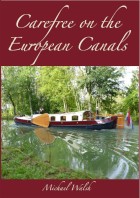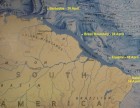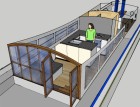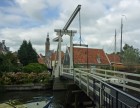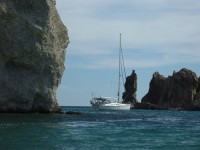Sequitur
Michael & Edi have headed out on a slow, thorough exploration of the globe.
| Vessel Name: | Sequitur and Zonder Zorg |
| Vessel Make/Model: | 2007 Hunter 49 and 1908 Wildschut Skûtsje |
| Hailing Port: | Vancouver, Canada |
| Crew: | Michael Walsh & Edi Gelin |
| About: | For our current location click, on Map & Tracking, then on the Google Earth logo. |
| Extra: | Follow us on Twitter: Follow @YachtSequitur |
| Social: |
13 January 2014
Another New Book Released
I am delighted to announce that my new book: Carefree on the European Canals is now in print and is available on Amazon.com, Amazon.ca [...]
26 April 2013
New Book Released
The proof copy of my new book arrived by courier today. I have approved it and it is now listed on Amazon for pre-order, with a publication date of 30 April. It is a rather large book at 680 pages in an 8.5 by 11 inch format with 315,000 words illustrated by over 2400 colour photos, charts and maps. [...]
24 April 2013
One Year Out of Brazil
One year ago today we sailed Sequitur out of Brazil after enduring more than six weeks in the least-friendly country that we had experienced during our three-year voyage. In the early evening of 24 April 2012 we crossed the line on the chart dividing Brazil from French Guyana and breathed a huge sigh [...]
27 October 2012 | Harlingen, Friesland
Planing a Metamorphosis
We have added a new post to the Zonder Zorg blog at: Planing a Metamorphosis.
29 September 2012 | Sneek, Netherlands
Onward to Friesland
We have arrived in Friesland and have added a new post to the skûtsje's blog at: Onward to Friesland
19 September 2012 | Hoorn, Netherlands
North From Aalsmeer
We have moved northward from Aalsmeer and I have added two new posts: Heading North From Aalsmeer and North From Amsterdam
13 September 2012 | Aalsmeer, Netherlands
Taking Possession
We are back in the Netherlands, and I have added some new posts to the ZonderZorg blog at: Taking Possession and Settling-In and Making Plans
20 August 2012 | Sequitur: St Augustine, USA - Michael & Edi: Vancouver, Canada - Nieuwe Zorg: Aalsmeer, Netherlands
Added a New Website
We have added a new website: Skûtsje ZonderZorg. Zonder zorg in Dutch means without worry. Our intention with the site is to provide a place to share some of the history, geography and culture of the skûtsje as we discover it. We will also use this place to document [...]
11 August 2012 | Sequitur: St Augustine, USA - Michael & Edi: Vancouver, Canada - Nieuwe Zorg: Aalsmeer, Netherlands
Still More Skûtsje History
We continued to attempt to track-down Douwe Albert Visser, who was the owner of Nieuwe Zorg in 1941 when she was re-registered. One of the problems we repeatedly encountered in our online searches was the effect of currently having Albert Visser and two Douwe Vissers as very competitive skûtsje racers, [...]
10 August 2012 | Sequitur: St Augustine, USA - Michael & Edi: Vancouver, Canada - Nieuwe Zorg: Aalsmeer, Netherlands
Some More Skûtsje History
While I was researching the history of Nieuwe Zorg, I finally found her first registration details obscured by an apparent typographical error in a transcribed online spreadsheet. She was listed as having been built in 1901 instead of 1908. I emailed the webmaster of the [...]
To the Atacama Desert
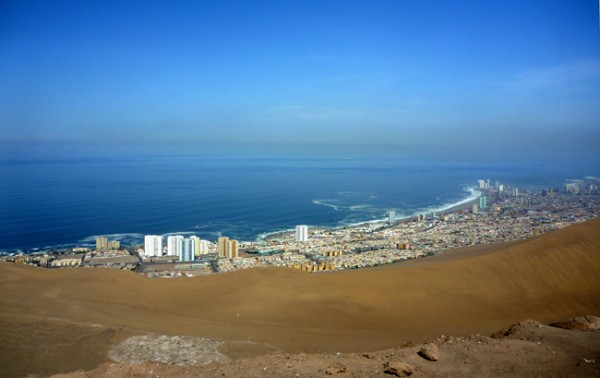
We celebrated New Year's Eve quietly onboard, and enjoyed a pleasant walk through the old town on New Year's Day. Then at 0830 on Sunday morning we were picked-up at the Yacht Club gate by Manuel, his wife, Sandra and his driver in a rather new 12-passenger Toyota bus. After stopping at a hotel to pick-up a man from Santiago and then at another to pick-up an ex-Chilean couple from Australia, we headed up the thousand-meter hillside above Iquique and into the Atacama Desert.

The Atacama Desert stretches for a thousand kilometres along the northern coast of Chile. It is known as the driest place on Earth, with many of its areas having received no measurable rainfall since record-keeping began. It is so arid that its mountains, which reach to nearly 6900 metres are completely glacier-free.
Areas of the Atacama are so dry and lifeless that NASA has been using them to test instrumentation in their Mars landers. In a series of tests in 2003 they duplicated tests that had been done on Mars in searching for signs of life, and found none. This is truly barren land.
However, this barren and desolate place is full of mineral wealth; large areas of its surface are covered with thick caked layers of salt-rich crust called caliches, and among the salt content is sodium nitrate, Chilean saltpetre. In the early 1800s came the discovery of what became the world's largest deposits of sodium nitrate, important in the production of fertilizer and high explosives. The deposits were in the unsettled northern areas of the Desert claimed by Bolivia, Peru and Chile. As the wealth of the area became more evident through the mid-1800s, the dispute over the territory grew. Several boundary treaties and agreements between the three countries finally fell apart when, after half-a-dozen years, Chile discovered an 1873 secret defensive pact between Peru and Bolivia. In 1879 Chile declared war on Peru and Bolivia, starting The War of the Pacific. In 1883 Chile emerged the victor, annexing the two southern provinces of Peru and the entire Pacific portion of Bolivia, leaving that country landlocked and effectively castrated.

The saltpetre mining boom brought huge wealth to Chile, but this was short-lived; in the early 1900s German chemists discovered a process for the chemical production of nitrate from ammonia. By 1940 the demand for Chilean saltpetre had declined dramatically, and the mines and mining towns were being abandoned by the scores, leaving some 170 ghost towns.

We first stopped at Santa Laura, about 1000 metres in elevation some 50 kilometres east of Iquique. This had been established by the Guillermo Wendell Nitrate Extraction Company in 1872, when the region was still a part of Peru. The company prospered and quickly grew into a thriving town in the middle of desert, with British machinery and British-styled buildings.

The company faltered, and in 1902 was taken-over, and then in 1913 its production was halted to change to a new extraction process, in an attempt to increase its production. The Great Depression caused a slump in demand and the company went into near bankruptcy before being taken-over in 1934 by COSATAN, (Compania Salitrera de Tarapaca y Antofagasta).

The company went into rapid decline and the works were abandoned in 1960. After becoming a ghost town, it was declared a national monument in 1970 and opened to tourism. In 2005 it was declared a UNESCO World Heritage Site.

We wandered through the nitrate extraction plant, with its receiving hoppers, crushers, conveyors, compressors and huge steam engines. Most of the remaining equipment appears to have had pieces and components scavenged by opportunists, but what remains is impressive.

Also impressive are the massive British Columbia and Oregon Douglas fir posts and beams that had been used in the construction. In the arid desert environment these pieces, some over 30 x 30 centimetres in size, are wonderfully preserved after more than 140 years.

The headquarters building has been turned into a museum with dioramas in many of the rooms showing the typical furnishings and goods in use at the time of the site's prosperity.

We got back into the bus and were driven a kilometre or so eastward to Humberstone. Like Santa Laura, this site was also established in 1872 by a British entrepreneur. James Thomas Humberstone established the Peru Nitrate Company, and named the site La Palma, which quickly grew to be one of the largest saltpetre extractors in the Atacama.

Like its neighbour Santa Laura, it approached bankruptcy and in 1934 La Palma was also acquired by COSATAN.

COSTAN renamed the site Oficiana Santiago Humberstone in honour of its founder. The townsite reached its maximum population of 3700 in 1940 and then began a rapid decline until it was abandoned in 1960. With Santa Laura, in 2005 it was declared a UNESCO World Heritage Site.

Half-a-century after they were abandoned, most of the buildings remain in a remarkable state of preservation, due in large measure to the extremely arid environment and also, I would think, to the remoteness from vandals.

Outstanding among the many well-preserved buildings is the theatre, which still retains most of its original interior. A lack of funding over the years has led to only the lower levels of the exterior having been painted, but again, the dry air has preserved the unprotected wood.

We were impressed with the bakery, which is a part of the community store. The huge stone bread ovens, the bread paddles, the receiving bins and the pile of fire wood all looked ready for the next batch. Throughout the site, the dioramas are well-done and show the way of life in this very remote corner of the world half-a-century and more ago.

One of the most fascinating places in Humberstone is the iron swimming pool. The pool was riveted together like a 19th century ship's hull. It appears ready for filling, though a look at the filter room shows that the huge circulating pump and the steam engine to power it both need some repair.

On display are some of the tiny, narrow-gauge locomotives that hauled the ore to the crushers and the finished product to the coast at Iquique.

Also on display is a passenger rail car that would be crowded with more than eight people. From the size of the car, we assumed that passenger demand was light.

Among the wonderfully organized displays was a two-room one depicting the mould-making shop for metal castings. Because of the extreme remoteness of the area, most machine pieces, as well as many day-to-day items needed to be fabricated locally. Ranged on the walls were wood carved forms that would have been used to make sand casts for all manner of items from huge gears, cams and pulleys to plumbing Ts, Ys and Us.

There was even a pair of moulds for a toilet bowl, and between them a cast iron toilet. I hope they had seats for them, because just the thought of sitting on an iron john gives me a pain in the butt.

There were displays of some of the typical kitchens found in the homes. We thought of re-modelling Sequitur's galley to give it more of this rustic look, akin to some of the galleys we have seen in 'traditional offshore sailboats', but in the end we decided Sequitur's clean, efficient and modern galley does just fine.

We re-boarded the bus and drove a short kilometre to the Pan-American Highway, which we then followed southward through the Atacama Desert. Shortly we drove through an oasis town in which were growing huge tamarugo trees. These are one of the few trees that prosper in the near waterless environment of the Atacama. They have one or two deep taproots, which extend as much as 15 metres down into the ground to reach water, but they also have a dense surface mat of roots to capture moisture from overnight dew.

As would be expected in such a harsh environment, the trees are very slow growing. We examined the stump of a recent pruned branch on one tree, and on it saw rings so closely spaced that they would require a good magnifying glass to count.

The cashew-shaped and sized seed pods are edible and provided a valuable source of nutrition for the indigenous people, as well as food for the Spanish conquistadors as they crossed the Atacama in their conquest of South America.

We continued to the southeast to the oasis town of Pica, where we were taken to the local swimming hole. It is a natural crack in the rocks, which reached down to the water table, where the water is 40 degrees. The small pool was so overcrowded, and the water was so murky that we wondered about its health safety. We decided against going in.
Pica is a very lush oasis town of about 6300 people. Large mango, lemon and lime orchards fill much of the oasis not taken up by housing, and there are large plantations of bell peppers and tomatoes, among other crops. The population increased by nearly 50% between the 1992 and the 2002 census, and has been increasing at the same rate since. There is concern that with the rapid increase of water for domestic and agricultural uses, the aquifers will be quickly depleted.

Manuel then escorted us to Restaurant Don Emilio, a simple establishment a few blocks away.

We sat down to an included-in-the-price lunch starting with a salad, followed by a choice of beef or chicken with the usual Peruvian accompaniment of both rice and potatoes. I asked Manuel about the Chileans using this practice of both starches together, and he reminded us that the people in the area were originally Peruvian, and they have kept their ways. Included in the price was a choice of beer or wine, and we finished with fruit, ice cream and coffee.
After lunch we went to a private swimming pool to relax. Edi and I didn't like the look of the water, and sat in the shade of an umbrella poolside while the others got dirty in the pool. Later, as we were visiting a church in the town, the man from Santiago received a cell phone call telling him of a magnitude 7.1 earthquake in the Valdivia area. We immediately thought of tsunami, and the huge devastation caused by the one the past February. We grew increasingly concerned about the safety of Sequitur sitting at the Yacht Club down in Iquique. In the open ocean, tsunamis travel at around 500 knots, and this means that if a tsunami had been generated by the quake, it could affect Iquique 2 hours and 20 minutes after the quake.
We expressed our concern and tried to get more information. The quake had occurred at 1720, so that meant a tsunami it generated would reach Sequitur at 1940. By then it was 1830, so it was impossible to make it back to Sequitur in time to do anything. The Santiago man got assurance that the short-duration quake was deep and inland, and that reports said there would be no tsunami.
As we drove into the desert across vast expanses of arid wasteland back toward Iquique, we couldn't stop thinking of the possibility of a devastating tsunami. We arrived back aboard Sequitur as the sun was setting, delighted and relieved to find her well and safe, and that there had been no tsunami from the earthquake.
It had been a wonderful day full of new insights of places dry and barren beyond imagination, places showing evidence of lost dreams, places lush and productive in the middle of vast wasteland and places in our minds full of fear and concern for Sequitur's safety. We were glad to be back aboard Sequitur, and will gladly take the dampness of the coast over the near-lifelessness of the Atacama.

